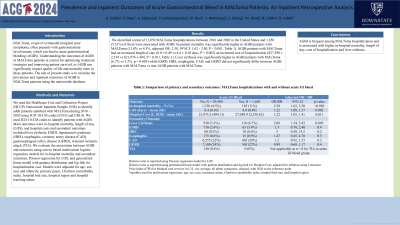Sunday Poster Session
Category: GI Bleeding
P0743 - Prevalence and Inpatient Outcomes of Acute Gastrointestinal Bleed in MALToma Patients: An Inpatient Retrospective Analysis
Sunday, October 27, 2024
3:30 PM - 7:00 PM ET
Location: Exhibit Hall E

Has Audio

Anwar Uddin, MD
SUNY Downstate Medical Center
Brooklyn, NY
Presenting Author(s)
Anwar Uddin, MD1, Prashil Dave, MD1, Aboud Kaliounji, MD2, Peter Lymberopoulos, MD1, Narinderjeet Kaur, MD, MS1, Yasmin Mahmoud, MD1, Justin Chung, MD3, Madia Ahad, MD1, Rafat Uddin, BA1, Rahat Uddin, MS1
1SUNY Downstate Medical Center, Brooklyn, NY; 2State University of New York Downstate, Brooklyn, NY; 3SUNY Downstate Health Sciences University, Brooklyn, NY
Introduction: MALToma, a type of extra nodal marginal zone lymphoma, often presents with gastrointestinal involvement, which can lead to acute gastrointestinal bleeding (AGIB). Understanding the outcomes of AGIB in MALToma patients is crucial for optimizing treatment strategies and improving patient survival, as AGIB can significantly impact quality of life and mortality rates in these patients. The aim of present study is to examine the prevalence and inpatient outcomes of AGIB in MALToma patients using the nationwide database.
Methods: We used the Healthcare Cost and Utilization Project (HCUP) Nationwide Inpatient Sample (NIS) to identify adult patients admitted with MALToma during 2016 – 2020 using ICD-10-CM codes (C83.0 and C88.4). We used ICD-10-CM codes to identify patients with AGIB. Main outcomes were in-hospital mortality, length of stay (LOS), and hospital costs and secondary outcomes included liver cirrhosis, ESRD, hepatorenal syndrome (HRS), esophagitis, coronary artery disease (CAD), gastroesophageal reflux disease (GERD), transient ischemic attack (TIA). We evaluate the association between AGIB and outcomes using survey based multivariate logistic regression models for in-hospital mortality and secondary outcomes, Poisson regression for LOS, and generalized linear model with gamma distribution and log link for hospitalization cost. Models were adjusted for age, sex, race and ethnicity, primary payer, Charlson comorbidity index, hospital bed size, hospital region and hospital teaching status.
Results: We identified a total of 31,050 MALToma hospitalizations between 2016 and 2020 in the United States and 1,650 (5.31%) of them were associated with AGIB. In‐patient mortality was significantly higher in AGIB patients with MALToma (11.0% vs 4.5%, adjusted OR: 2.38, 95%CI: 1.62 - 3.50, P < 0.001, Table 1). AGIB patients with MALToma had an increased length of stay (8.0 ± 0.49 vs 6.4 ± 0.10 days, P = 0.002) an increased cost of hospitalization ($27,590 ± 2,339 vs $21,974 ± 494, P = 0.011, Table 1). Liver cirrhosis was significantly higher in AGIB patients with MALToma (6.7% vs 3.2%, p = 0.005) while ESRD, HRS, esophagitis, CAD, and GERD did not significantly differ between AGIB patients with MALToma vs non-AGIB patients with MALToma.
Discussion: AGIB is frequent among MALToma hospitalization and is associated with higher in‐hospital mortality, length of stay, cost of hospitalization and liver cirrhosis.
Note: The table for this abstract can be viewed in the ePoster Gallery section of the ACG 2024 ePoster Site or in The American Journal of Gastroenterology's abstract supplement issue, both of which will be available starting October 27, 2024.
Disclosures:
Anwar Uddin, MD1, Prashil Dave, MD1, Aboud Kaliounji, MD2, Peter Lymberopoulos, MD1, Narinderjeet Kaur, MD, MS1, Yasmin Mahmoud, MD1, Justin Chung, MD3, Madia Ahad, MD1, Rafat Uddin, BA1, Rahat Uddin, MS1. P0743 - Prevalence and Inpatient Outcomes of Acute Gastrointestinal Bleed in MALToma Patients: An Inpatient Retrospective Analysis, ACG 2024 Annual Scientific Meeting Abstracts. Philadelphia, PA: American College of Gastroenterology.
1SUNY Downstate Medical Center, Brooklyn, NY; 2State University of New York Downstate, Brooklyn, NY; 3SUNY Downstate Health Sciences University, Brooklyn, NY
Introduction: MALToma, a type of extra nodal marginal zone lymphoma, often presents with gastrointestinal involvement, which can lead to acute gastrointestinal bleeding (AGIB). Understanding the outcomes of AGIB in MALToma patients is crucial for optimizing treatment strategies and improving patient survival, as AGIB can significantly impact quality of life and mortality rates in these patients. The aim of present study is to examine the prevalence and inpatient outcomes of AGIB in MALToma patients using the nationwide database.
Methods: We used the Healthcare Cost and Utilization Project (HCUP) Nationwide Inpatient Sample (NIS) to identify adult patients admitted with MALToma during 2016 – 2020 using ICD-10-CM codes (C83.0 and C88.4). We used ICD-10-CM codes to identify patients with AGIB. Main outcomes were in-hospital mortality, length of stay (LOS), and hospital costs and secondary outcomes included liver cirrhosis, ESRD, hepatorenal syndrome (HRS), esophagitis, coronary artery disease (CAD), gastroesophageal reflux disease (GERD), transient ischemic attack (TIA). We evaluate the association between AGIB and outcomes using survey based multivariate logistic regression models for in-hospital mortality and secondary outcomes, Poisson regression for LOS, and generalized linear model with gamma distribution and log link for hospitalization cost. Models were adjusted for age, sex, race and ethnicity, primary payer, Charlson comorbidity index, hospital bed size, hospital region and hospital teaching status.
Results: We identified a total of 31,050 MALToma hospitalizations between 2016 and 2020 in the United States and 1,650 (5.31%) of them were associated with AGIB. In‐patient mortality was significantly higher in AGIB patients with MALToma (11.0% vs 4.5%, adjusted OR: 2.38, 95%CI: 1.62 - 3.50, P < 0.001, Table 1). AGIB patients with MALToma had an increased length of stay (8.0 ± 0.49 vs 6.4 ± 0.10 days, P = 0.002) an increased cost of hospitalization ($27,590 ± 2,339 vs $21,974 ± 494, P = 0.011, Table 1). Liver cirrhosis was significantly higher in AGIB patients with MALToma (6.7% vs 3.2%, p = 0.005) while ESRD, HRS, esophagitis, CAD, and GERD did not significantly differ between AGIB patients with MALToma vs non-AGIB patients with MALToma.
Discussion: AGIB is frequent among MALToma hospitalization and is associated with higher in‐hospital mortality, length of stay, cost of hospitalization and liver cirrhosis.
Note: The table for this abstract can be viewed in the ePoster Gallery section of the ACG 2024 ePoster Site or in The American Journal of Gastroenterology's abstract supplement issue, both of which will be available starting October 27, 2024.
Disclosures:
Anwar Uddin indicated no relevant financial relationships.
Prashil Dave indicated no relevant financial relationships.
Aboud Kaliounji indicated no relevant financial relationships.
Peter Lymberopoulos indicated no relevant financial relationships.
Narinderjeet Kaur indicated no relevant financial relationships.
Yasmin Mahmoud indicated no relevant financial relationships.
Justin Chung indicated no relevant financial relationships.
Madia Ahad indicated no relevant financial relationships.
Rafat Uddin indicated no relevant financial relationships.
Rahat Uddin indicated no relevant financial relationships.
Anwar Uddin, MD1, Prashil Dave, MD1, Aboud Kaliounji, MD2, Peter Lymberopoulos, MD1, Narinderjeet Kaur, MD, MS1, Yasmin Mahmoud, MD1, Justin Chung, MD3, Madia Ahad, MD1, Rafat Uddin, BA1, Rahat Uddin, MS1. P0743 - Prevalence and Inpatient Outcomes of Acute Gastrointestinal Bleed in MALToma Patients: An Inpatient Retrospective Analysis, ACG 2024 Annual Scientific Meeting Abstracts. Philadelphia, PA: American College of Gastroenterology.
